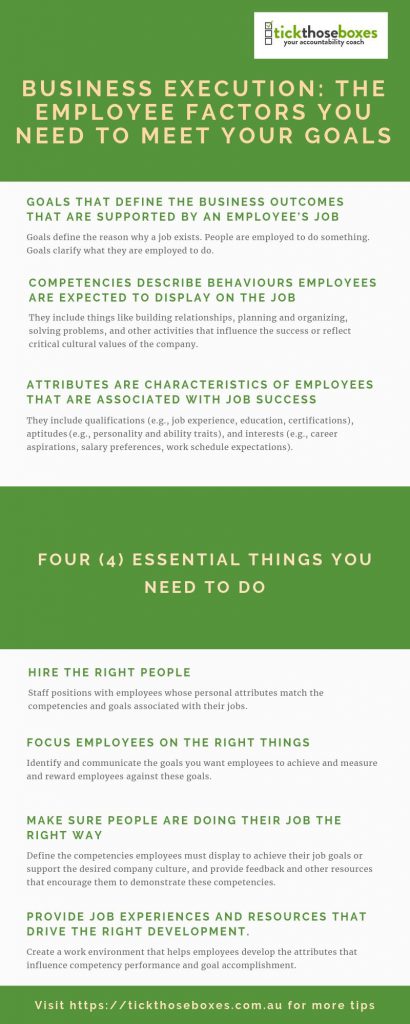
Posted on: 04/09/2019

Business execution is about having the employees required to support a company’s strategy and making sure they are doing what the company needs them to do to achieve its strategic goals.
Companies increase business execution capability through ensuring the right people are doing the right things in the right way to support the company’s strategic objectives. Sustainable business execution requires doing this in a way that fosters the proper development so employees acquire capabilities the company will need in the future.
The best way to improve business execution is to increase employee performance levels. Higher levels of job performance lead directly to stronger business execution overall. Increasing job performance ultimately depends on managing and influencing three things:
Goals define “what” a person is supposed to do in the job, and competencies describe “how” they are expected to do it.
Four (4) essential things you need to do;
The relationship between attributes, skills, and goals can be summed up as “Who you are (attributes) influences how you act (competencies), which determines what you achieve (goals).” Any effort to increase business execution must ultimately influence employee attributes, competencies or goals to be successful. All processes that effectively increase employee performance, engagement, retention, or any other variable associated with the behaviour of individual employees will at some point focus on aligning, clarifying, or developing employee attributes, competencies, and goals.
There are four basic ways to influence employee attributes, competencies, and goals: hire the right people, focus them on the right things, ensure they are doing things the right way, and foster the right development.
Right people, right things, the right way, and proper development reflect the four fundamental aspects of an integrated talent management system. These activities roughly correspond with the “traditional” talent management processes of staffing, goal management, performance management and succession.

If you like what your reading and this resonates with you, as your ‘Accountability Coach’ I’ll keep you on track, so you keep those promises and commitments made to others and yourself.
If we do this right, you’ll increase your sales, service your clients better, make more money and work fewer hours. Now you can spend it with those that are most important and not doing work.
Visit my website to find how we can work together: https://tickthoseboxes.com.au/working-with-me
If you need help with your business, I work with entrepreneurial business owners, executives and their teams to ensure full accountability so they can meet obligations, promises and commitments made to others and themselves.
For more info reach out to us at questions@tickthoseboxes.com.au
I was excited to join Tia Harmer on The Work in Progress: The Personal Productivity Science Insights Podcast! We dive deep into the science of goal setting and the power of accountability—two cornerstones of business and personal success.